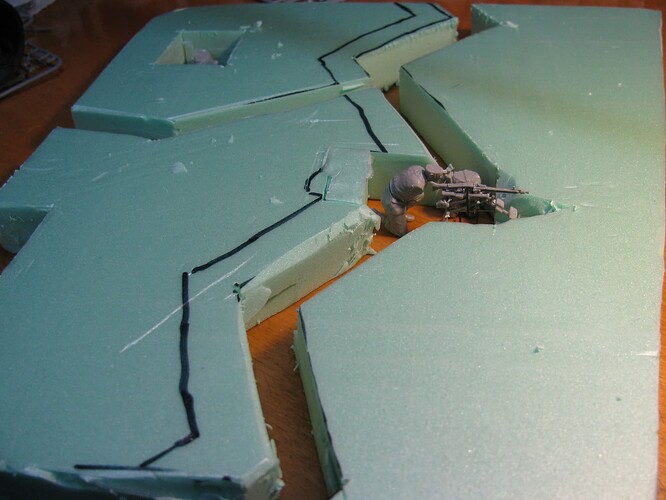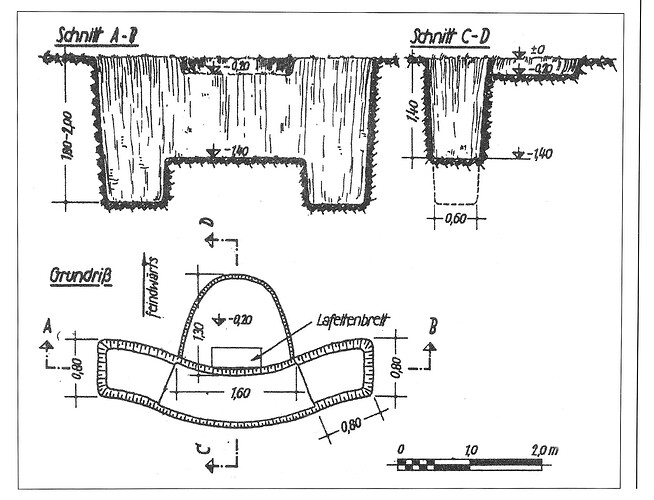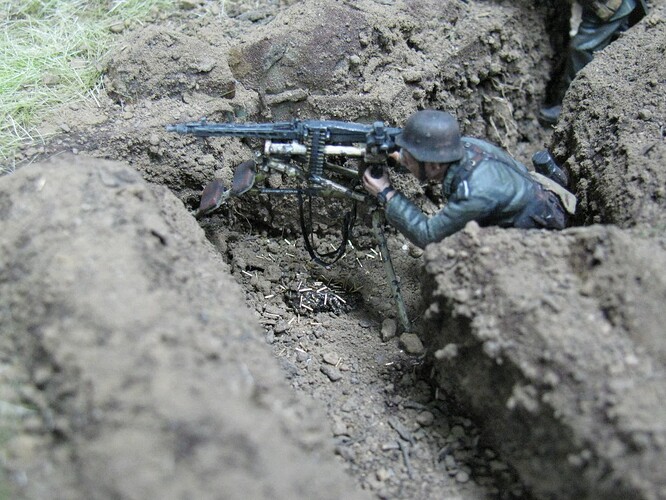For quite some time now and after discussions on other online forums I have wanted to build a dio showing WWII trenches. The vast majority of scale renderings of this I’ve seen show the trench as a kind of super highway thing. Judging from the photo evidence and also from my experience as a glorified ditch digger ( infantryman) I know this not to be th case. Trenches since they were hand dug usually with small e-tools were never that wide. Too much work and also not as much ballistic protection. Plus, they were zig zagged so if a shell hit the shrapnel would not go right down the ditch ! Same thing for enemies invading the trench. If they made it into the system then a straight trench would let them machinegun right down a straight ditch!
So here is what I began with. Nice light insulation foam board… I will try to replicate a snapshot of a small area of a defensive position with MG pits and a commo trench to the rear to link the forward trench with subsequent lines and also a command dugout and mortar dugout. Trying to compress and company wide zone into a small space.
I picked a German unit since the Western Allied did not have much time to dig things like this as they were mobile and really hadn’t much need.
The start point.
The overall concept here will be a position that has been occupied for about 2 days. Enough time for the Landsers to turn their small initial scrapes into proper positions and then connect them with trenches. As long as they had time they would improve these positions by digging deeper ( if possible ) and also adding overhead cover, commo trenches, subsequent lines of trenches, et etc. Minefields and barbed wire of course, if thy had access to those munitions. One thing you would not see hardly any of were sandbags. Too much effort to bring them up the long and shaky supply system.
Ok so here we go.
J
Did some upgrades on a Dragon MG lafette. Now I just saw they will be releasing a super detailed version. Hahahahaha of course. But whatever…I had fun.
J
This site may be of some interest: https://www.allworldwars.com/German%20Field%20Fortifications%20on%20the%20Eastern%20Front.html
![]()
![]()
When building really elaborate trench systems like the one in your diorama, would better equipment (long handled hoes, picks, and shovels) be provided? Does a typical infantry company have a truck full of digging equipment sitting in reserve for big trench building jobs?
Your trench looks about two feet deep. Is that normal for a defensive trench system? Wouldn’t deeper be much better?
What happens to all the fill dirt removed from the trench? Is it made into ridge in front of the trench?
Is there a set procedure for progressively improving trenches?
The diorama looks really interesting. It would be neat to compare and contrast trench systems at different phases of development–fox hole, trench, interconnected trenches, deep trench with bunkers, defense in depth trench system, defense in depth system with fortifications and trenches. In my opinion, that sort of thing would make a good museum display, showing how one aspect of how warfare works.
Nice plan J … will be good watching this build up … or down in this case ![]()
![]()
Interesting read ![]()
Thanks buddy. Great intell,although late for me as this thing has progressed a lot already.
J
Thanks, Literally all your questions were answered in my caption.
Yes the dirt in most cases was tossed to the front to create the parapet and thus increase cover in conjunction with the ditch.
I had also pondered making a set of progressive improvement type dios but I do not think I would retain my interest long enough for a project like that.
I know myselff too well,
J
Thank you sir!.
J
I do not understand but that’s fine. I will look it up online. It looks like a fun project.
Nice, and nice project. Over the years I’ve been surprised by how many photos of trenches in WW2 on the eastern front I’ve seen. Most of them seemed to be early war Russian constructions and I’ve wondered how many of the German ones had actually been captured and repurposed.
the only ones not covered by my caption I answered in my response but I just noticed the one about the pioneer tools carried in the trucks. At the point in the war I am showing the Germans had nothing much like that available. They had already lost vast amounts of vehicles of all types and typical infantry units had just their feet or maybe some horse drawn vehicles that carried the bare essentials like food and ammo. So most digging was done by personal entrenching tools.
J
Just for consideration, here’s a drawing of what a “standardized”, stand-alone, heavy MG emplacement would look like, taken from a German field manual.
Of course, such exacting dimensions would be cast aside if conditions didn’t warrant such formalities.
Many many ditches were dug by both sides in that long war. The red army waas known for the amazing amount of digging that they could do just in one night ! This is why the Germans usually counter-attacked as fast as possible as to not let the Reds dig in too much.
J
Looks about right. You are correct, the situation on the ground didn’t always match the field manual plus the troops may well not be so well trained. Lots of factors involved.
I am trying to show a system not brand new but also not very well developed yet.
J
I will be following this with interest. I haven’t used any of the insulation foam for any of my projects yet, so I am glad to see how you are using it for your trench system. I like the fact that you are depicting the trenches as a work in progress so to speak. I remember setting up defensive positions where we would occupy and secure a site, then hasty positions were dug, then our main fighting positions, and then as time and the situation permitted, improvements to the positions were made as well as secondary positions, communication trenches, etc. implemented.
Thanks buddy. Yeah I hope I can make things understandable in the future. Seems to be some confusion for others so far a bit.
J
The 42 with lafette before I add the asst. gunner so hopefully you can check the pile of spent brass.
J
Lovely work mate. I also like the worn leather tones on the tripod pads. nice touch.
Thanks John,
J




